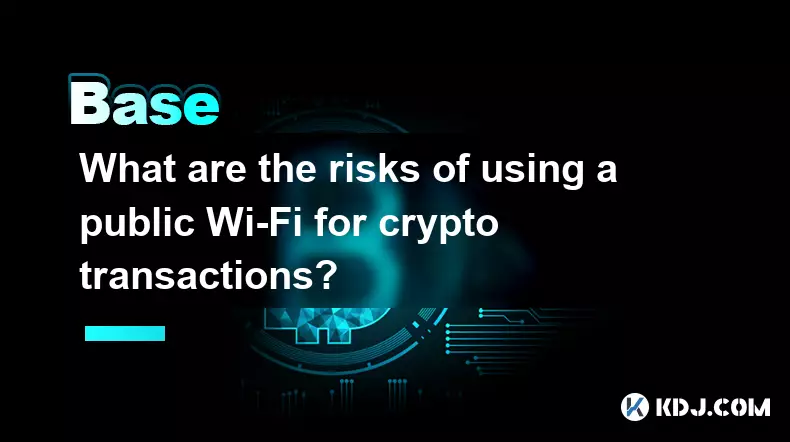-
 bitcoin
bitcoin $106680.127705 USD
0.67% -
 ethereum
ethereum $3615.722480 USD
-0.65% -
 tether
tether $0.999925 USD
-0.04% -
 xrp
xrp $2.550072 USD
5.91% -
 bnb
bnb $1002.572269 USD
-0.90% -
 solana
solana $168.746669 USD
1.08% -
 usd-coin
usd-coin $0.999832 USD
-0.03% -
 tron
tron $0.297244 USD
1.97% -
 dogecoin
dogecoin $0.182965 USD
0.71% -
 cardano
cardano $0.600432 USD
2.56% -
 hyperliquid
hyperliquid $41.439691 USD
-1.57% -
 chainlink
chainlink $16.548399 USD
2.40% -
 bitcoin-cash
bitcoin-cash $524.993680 USD
3.45% -
 stellar
stellar $0.302259 USD
4.10% -
 zcash
zcash $539.994871 USD
-16.31%
What are the risks of using a public Wi-Fi for crypto transactions?
Avoid crypto transactions on public Wi-Fi—unsecured networks expose private keys, enable hacking via fake hotspots, and risk fund theft through session hijacking or packet sniffing.
Nov 10, 2025 at 12:19 am

Risks of Conducting Crypto Transactions on Public Wi-Fi Networks
1. Public Wi-Fi networks are inherently insecure, often lacking encryption protocols that safeguard data transmission. When users engage in cryptocurrency transactions over such networks, their private keys and wallet credentials become vulnerable to interception by malicious actors monitoring the same connection.
2. Man-in-the-middle (MitM) attacks are prevalent on unsecured hotspots. In this scenario, a hacker positions themselves between the user and the exchange or wallet service, silently capturing login details, transaction data, and even two-factor authentication codes without the user’s knowledge.
3. Fake Wi-Fi access points, also known as 'evil twin' networks, mimic legitimate public networks. Unsuspecting users may connect to these rogue hotspots, believing they are accessing free airport or café internet, only to have all their digital activity harvested in real time.
4. Session hijacking can occur when an attacker steals active session cookies from a logged-in crypto exchange account. This allows immediate access to the user's funds without needing passwords, especially if multi-factor authentication is disabled or bypassed through social engineering.
5. Unencrypted traffic exposes URLs and API calls used during blockchain interactions. Even if login credentials are secure, transaction destinations and amounts can be logged, enabling targeted phishing campaigns or physical threats based on perceived wealth.
Data Exposure Through Network Sniffing Tools
1. Cybercriminals use packet sniffers like Wireshark or bettercap to capture raw data flowing across open networks. These tools can extract sensitive information such as IP addresses linked to wallet logins, transaction timestamps, and destination wallet addresses.
2. If a crypto application does not enforce HTTPS or uses outdated SSL certificates, transmitted data becomes readable in plain text. Attackers can exploit this weakness to reconstruct user behavior patterns and identify high-value targets.
3. Mobile apps that auto-sync with cloud backups over public Wi-Fi may leak wallet recovery phrases or biometric unlock logs. Once captured, attackers can restore full control of digital assets remotely.
4. DNS spoofing redirects users to counterfeit versions of popular exchanges like Binance or Coinbase. The fake sites appear identical but collect every keystroke, including withdrawal addresses and PIN entries.
5. Persistent tracking through device fingerprinting enables long-term surveillance. Even after leaving the network, attackers can correlate future transactions back to the original exposed session.
Device-Level Vulnerabilities Amplify Threats
1. Many smartphones and laptops have file-sharing features enabled by default, exposing local storage to nearby hackers on the same subnet. Private key files stored in accessible folders could be silently copied.
2. Outdated operating systems lack patches for known exploits, making them easy targets for malware injection via Wi-Fi. Once infected, devices may record keystrokes or redirect outgoing transactions to attacker-controlled wallets.
3. Automatic network reconnection settings increase exposure. Devices previously connected to a compromised hotspot might reconnect without user consent, reopening attack vectors during subsequent visits.
4. Jailbroken or rooted devices bypass built-in security layers, increasing susceptibility to privilege escalation attacks launched from adjacent machines on shared networks.
5. Bluetooth and Wi-Fi proximity services can be abused to deliver payloads disguised as firmware updates or peer-to-peer payment requests, tricking users into authorizing unauthorized transfers.
Common Questions About Crypto Security on Public Networks
Q: Can using a mobile data connection reduce risks compared to public Wi-Fi?A: Yes. Mobile data typically employs stronger encryption and authentication mechanisms than open Wi-Fi. Carriers authenticate devices through SIM cards, reducing the likelihood of impersonation attacks. However, users should still avoid conducting transactions on untrusted devices or while using public charging stations that enable data transfer.
Q: Does enabling a VPN fully protect crypto transactions on public networks?
A: A reputable, no-logs VPN encrypts all traffic between the device and the exit server, preventing local eavesdropping. However, it does not protect against endpoint compromises such as malware, phishing, or insecure applications. Users must ensure the VPN provider is trustworthy and does not log connection metadata that could link identities to wallet activity.
Q: Are hardware wallets immune to public Wi-Fi threats?
A: Hardware wallets provide significant protection by isolating private keys from network-connected devices. However, if the companion software or transaction verification process occurs on a compromised computer or phone connected to public Wi-Fi, attackers can alter recipient addresses or approve fraudulent transactions before signing.
Q: What immediate steps should be taken after realizing a transaction was made on an unsafe network?
A: Revoke any active API keys used for exchanges, update passwords with strong unique combinations, and enable hardware-based two-factor authentication. Transfer funds to a newly generated wallet created offline. Monitor account activity closely and consider freezing sensitive accounts until device integrity is confirmed.
Disclaimer:info@kdj.com
The information provided is not trading advice. kdj.com does not assume any responsibility for any investments made based on the information provided in this article. Cryptocurrencies are highly volatile and it is highly recommended that you invest with caution after thorough research!
If you believe that the content used on this website infringes your copyright, please contact us immediately (info@kdj.com) and we will delete it promptly.
- Meme Coins, Degen Alpha, and Market Updates: Navigating the Crypto Landscape
- 2025-11-11 19:00:02
- XRP and Dogecoin: Millionaire-Maker Showdown or Just a Meme?
- 2025-11-11 18:50:01
- Decoding Crypto Trends: Square's Bitcoin Leap, McRib's Market Magic, and the Altcoin Surge
- 2025-11-11 19:50:01
- CryptoQuant: ETF Buying on Thin Ice? Sellers Primed to Dominate
- 2025-11-11 19:10:02
- Altcoin ETF Mania: XRP ETF Launch Date Buzz and Beyond!
- 2025-11-11 19:50:01
- Uniswap's UNI Surges: Burn Mechanism Ignites Price Rally!
- 2025-11-11 19:10:02
Related knowledge

What is the difference between a transparent and a shielded transaction?
Nov 10,2025 at 05:59pm
Understanding Transparent Transactions in Cryptocurrency1. Transparent transactions are the standard form of transaction on most public blockchains li...

What is a "crypto airdrop farmer" and what strategies do they use?
Nov 09,2025 at 03:39pm
What Is a Crypto Airdrop Farmer?1. A crypto airdrop farmer is an individual who actively participates in blockchain projects to qualify for free token...

How does a crypto insurance protocol work?
Nov 08,2025 at 12:39am
Understanding Crypto Insurance Protocols1. A crypto insurance protocol operates by offering financial protection against losses incurred from digital ...

What is token composability and why is it called "DeFi Legos"?
Nov 09,2025 at 06:39am
Bitcoin's Role in Decentralized Finance1. Bitcoin remains the cornerstone of decentralized finance, serving as a benchmark for value and trustlessness...

What is an "exploit" versus a "hack" in the context of smart contracts?
Nov 09,2025 at 12:40am
Understanding Exploits in Smart Contracts1. An exploit refers to the utilization of a known vulnerability within a smart contract’s code to gain unint...

What is a decentralized storage network and how does it compare to cloud services?
Nov 07,2025 at 11:59pm
Understanding Decentralized Storage Networks1. A decentralized storage network distributes data across a peer-to-peer infrastructure rather than relyi...

What is the difference between a transparent and a shielded transaction?
Nov 10,2025 at 05:59pm
Understanding Transparent Transactions in Cryptocurrency1. Transparent transactions are the standard form of transaction on most public blockchains li...

What is a "crypto airdrop farmer" and what strategies do they use?
Nov 09,2025 at 03:39pm
What Is a Crypto Airdrop Farmer?1. A crypto airdrop farmer is an individual who actively participates in blockchain projects to qualify for free token...

How does a crypto insurance protocol work?
Nov 08,2025 at 12:39am
Understanding Crypto Insurance Protocols1. A crypto insurance protocol operates by offering financial protection against losses incurred from digital ...

What is token composability and why is it called "DeFi Legos"?
Nov 09,2025 at 06:39am
Bitcoin's Role in Decentralized Finance1. Bitcoin remains the cornerstone of decentralized finance, serving as a benchmark for value and trustlessness...

What is an "exploit" versus a "hack" in the context of smart contracts?
Nov 09,2025 at 12:40am
Understanding Exploits in Smart Contracts1. An exploit refers to the utilization of a known vulnerability within a smart contract’s code to gain unint...

What is a decentralized storage network and how does it compare to cloud services?
Nov 07,2025 at 11:59pm
Understanding Decentralized Storage Networks1. A decentralized storage network distributes data across a peer-to-peer infrastructure rather than relyi...
See all articles









































































